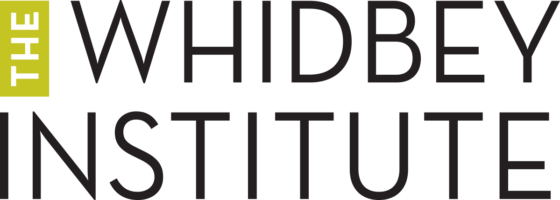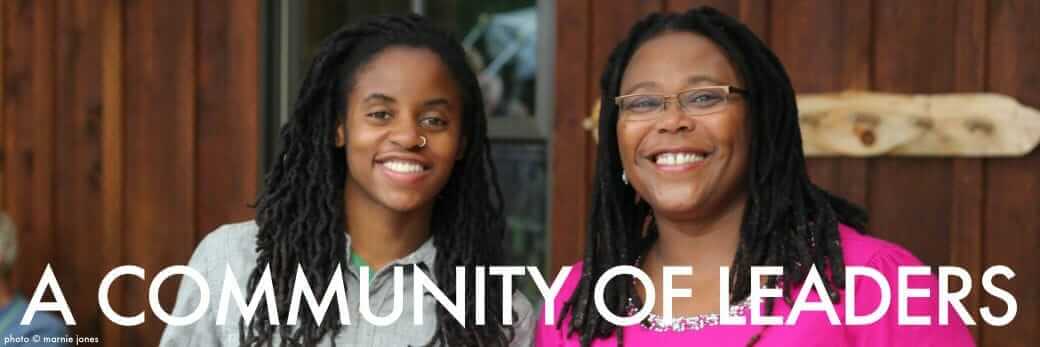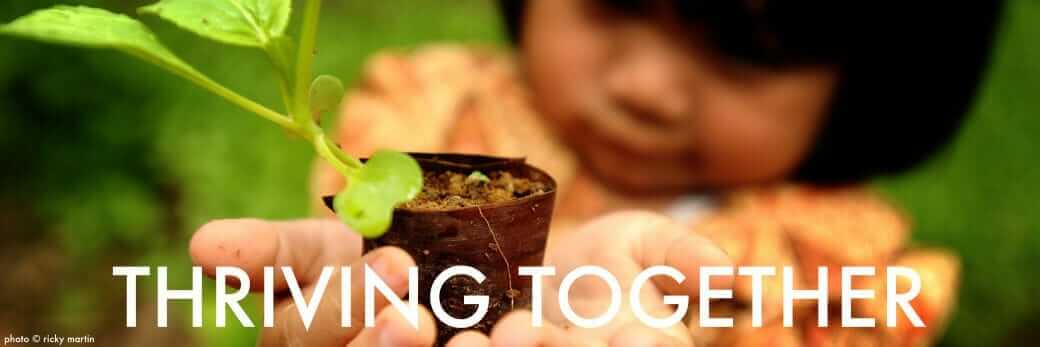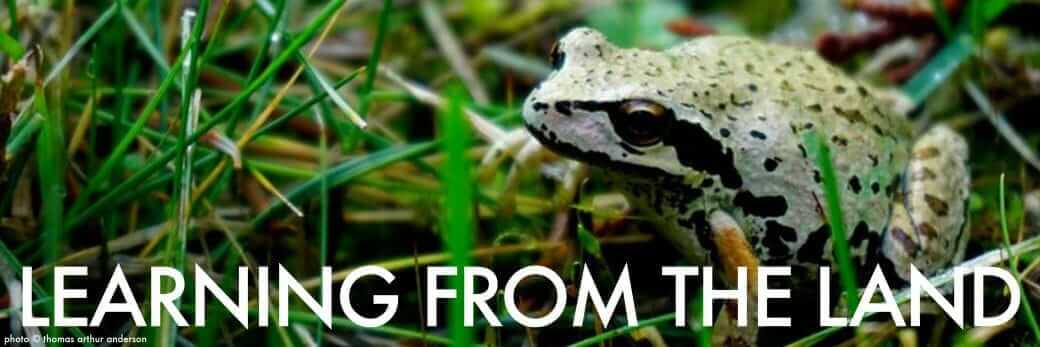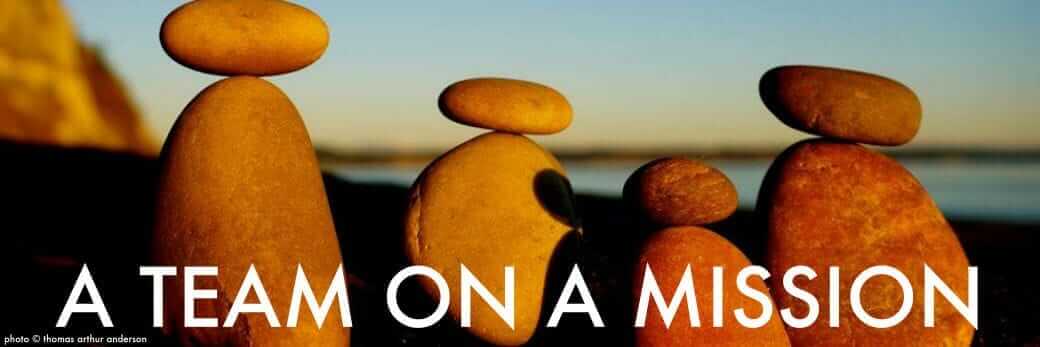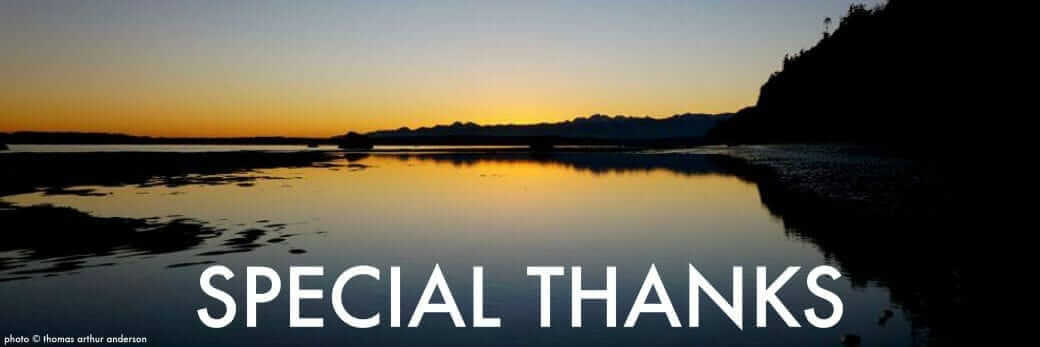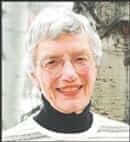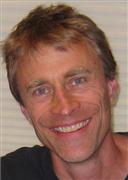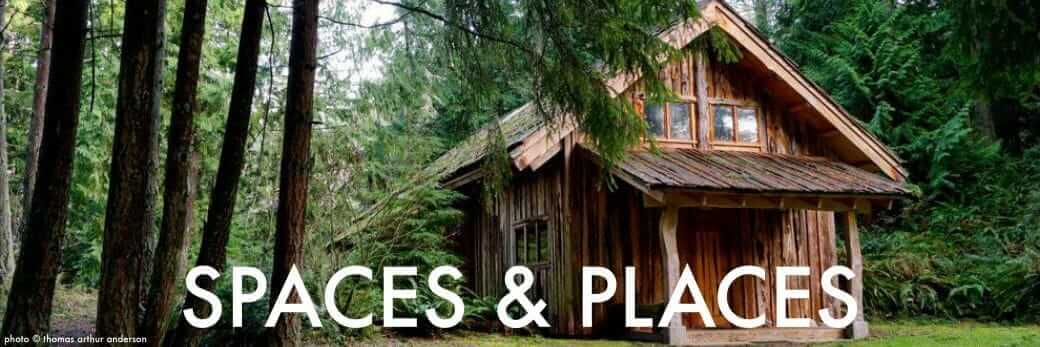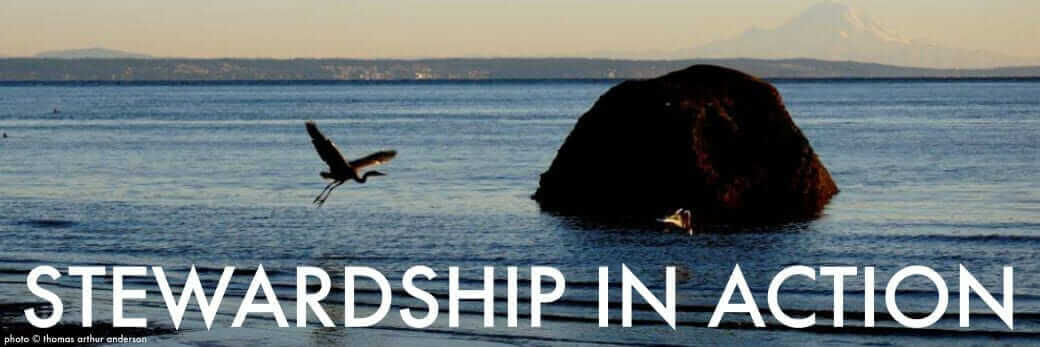This online report is part of our commitment to steward our resources with care—plus, we get to share our stories and those of our partners more fully on the web. Thank you for joining us here, and for all you do to make this work come alive!
Table of Contents:
Our Shared Purpose | A Community of Leaders | Thriving Together | Learning from the Land
A Team on a Mission | Special Thanks | Spaces and Places | Stewardship in Action
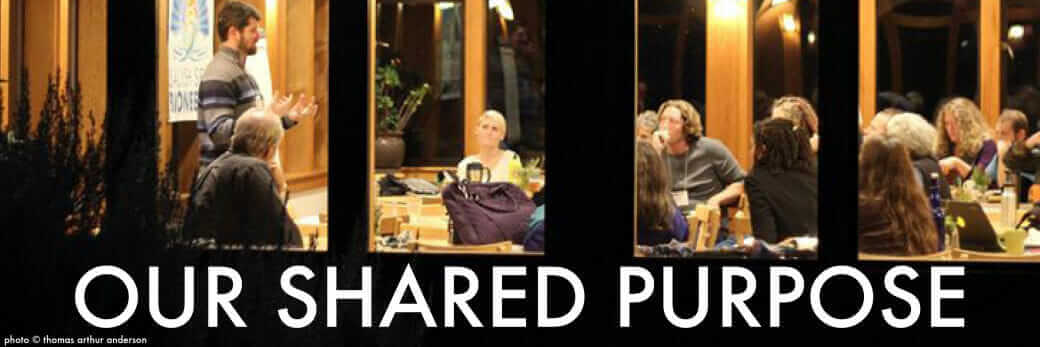
“In reality, there is a single integral community of the Earth that includes all its component members whether human or other than human. In this community every being has its own role to fulfill, its own dignity, its own inner spontaneity. Every being has its own voice.” —Thomas Berry
As a community of leaders supporting and advancing positive social and environmental change, the Whidbey Institute is built on commitment to shared purpose. The inspiring stories that emerged here in 2014, both at Chinook and elsewhere in our learning community, have rocked our world! We continue to nurture and connect people with, and on, our 100 acres of northwest woodland, and we’ve expanded into Seattle to bring more people together across across diverse communities and sectors of society. Together, we’re doing even more uncommon work for the common good.
Our network is interconnected and diverse, made up of change agents in Cascadia and around the world – working individually, in organizations, in communities, and across movements. We are united by a commitment to hope and optimism that we can rejuvenate our world, living in coherence with nature and with each other for the good of all.
LOOKING AHEAD TO OUR FIFTH DECADE
The Whidbey Institute has a bright future, thanks to the support and dedication of the hundreds of individuals and organizations who have played a part in its development.
From our home at Chinook and our new presence at Impact Hub Seattle, we stand for transformative leadership, thriving communities, and ecosystem vitality. Our network of mission-aligned partners is growing, along with our reach—and our ability to do more work, in more ways, for the common good. Our inspired and diverse team of board and staff is proud of our strong vision and impact, and grateful for the sustaining support of the friends, fellows, donors, partners, and volunteers who work, with us, toward a more sustainable and just future. We invite you to find YOUR way here!
As we move into our fifth decade, we draw from both our founding values and our contemporary vision in meeting today’s most critical challenges.
During our October 2014 Celebration of Gratitude, we shared updates on priority stewardship projects at Chinook, how our programs and partnerships have evolved, and how we’re expanding our impact for the common good throughout Cascadia. Some of those updates are shared in the slideshows below.
We were grateful for the chance to dream together into what the future holds! The Celebration included a Gala dinner auction—during which we experienced once again the incredible support which makes this work possible—and a Community Festival which brought all ages together to learn, explore, play, and celebrate on the land.
We cannot do this work alone, and invite you to stay meaningfully engaged with our programs, visiting the land, volunteering, or contributing other resources.
OUR CHERISHED COLLABORATORS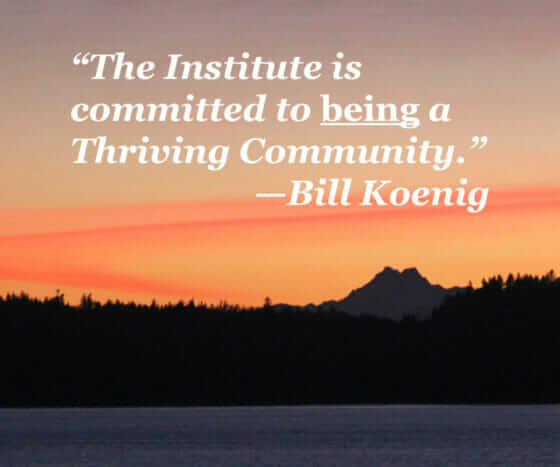
As part of understanding our role and responsibilities as a change-making organization in a rapidly-evolving world, we at the Whidbey Institute revised and refined our strategic plan in 2014 in order to “be the change we wish to see.”
From the innermost workings of our staff and board structure to the ways in which we engage with our program partners and our community, we’re committed to the values of trust, transparency, and leadership from within. We are grateful to several key collaborators who helped us in illuminating the practices and policies which will support our organization in continuing to embody these values. In addition to every member of our leadership-rich staff and board, we particularly wish to thank Barbara Schaetti, Chris Clark, Bill Koenig, Thomas Anderson, Heather Johnson, and Rick Jackson.
LIVING THE NEW STORY
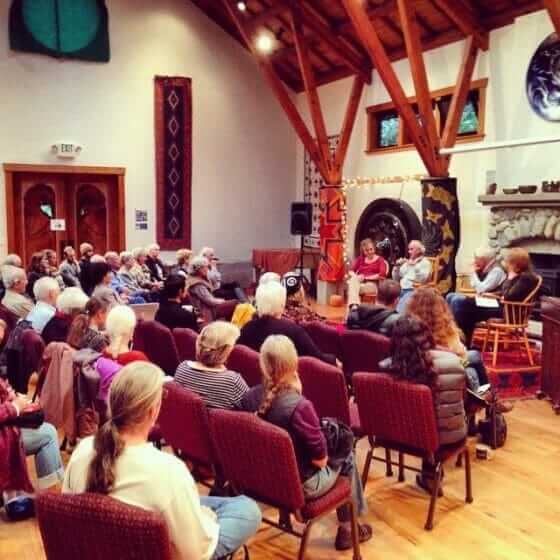 November 9th, 2014 marked Thomas Berry’s 100th birthday and the close of our Salish Sea Bioneers program. It presented a special opportunity to celebrate the life and work of the late Berry, a scholar and a Catholic priest of the Passionist order, whose body of ecotheology work has deeply informed the purpose of the Whidbey Institute. Whidbey Institute Founder Fritz Hull, with Senior Fellows Sharon Parks and Larry Daloz, came together to share stories of their experiences with this extraordinary human being and to revisit the deep importance of the “Great Work of our time,” to which he’d dedicated his life.
November 9th, 2014 marked Thomas Berry’s 100th birthday and the close of our Salish Sea Bioneers program. It presented a special opportunity to celebrate the life and work of the late Berry, a scholar and a Catholic priest of the Passionist order, whose body of ecotheology work has deeply informed the purpose of the Whidbey Institute. Whidbey Institute Founder Fritz Hull, with Senior Fellows Sharon Parks and Larry Daloz, came together to share stories of their experiences with this extraordinary human being and to revisit the deep importance of the “Great Work of our time,” to which he’d dedicated his life.
In Berry’s words, “the Great Work before us, the task of moving modern industrial civilization from its present devastating influence on the Earth to a more benign mode of presence, is not a role that we have chosen. It is a role given to us, beyond any consultation with ourselves. We did not choose. We were chosen by some power beyond ourselves for this historical task. We do not choose the moment of our birth, who our parents will be, our particular culture or the historical moment when we will be born. We do not choose the status of spiritual insight or political or economic conditions that will be the context of our lives. We are, as it were, thrown into existence with a challenge and a role that is beyond any personal choice. The nobility of our lives, however, depends upon the manner in which we come to understand and fulfill our assigned role.”
After an afternoon of tender and compelling conversation, there could have been no more perfect close than Vivienne Hull’s recitation of a poem she had written and read for Thomas at his 80th birthday celebration, and which she says he carried around in his pocket in the days thereafter.
OUR EVOLVING PARTNERSHIPS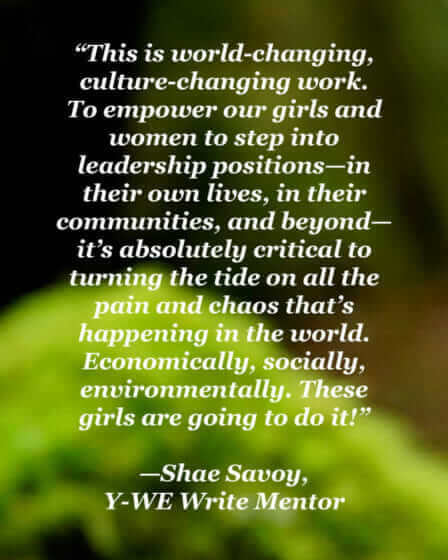
Y-WE Write
In August, we welcomed a group of young women for Y-WE Write, a literacy and leadership camp which organizers called “a 5-day exploration of young women’s voices, stories, dreams and talents.”
The camp is a collaboration between two of our Program Partners—Hedgebrook and Young Women Empowered—with leadership from Nadia Cheney and Dev Majkut as well as a group of inspiring volunteer mentors and authors.
After a spectacular week with this extraordinary group of women and girls, we spoke with mentor Shae Savoy and participant Livia Lomne about their experiences in this program.
Shae Savoy describes herself as a poet and youth empowerment educator, and said that after Y-WE Write she joined Young Women Empowered as a staff member and facilitator. Being a Y-WE Write mentor was profoundly moving, both in how she witnessed girls being nurtured and in how she experienced the week herself.
“From the very beginning we intentionally created a unique, supportive, electrifying community for the girls and the women,” she said. Shae then spoke of what she called “positive girl culture,” which for some girls was a new experience. “These girls got to experience real solidarity and sisterhood—and were continuously invited into their highest selves.”
The camp activities ranged from writing to movement, dance, singing, and theatre, and campers ranged from girls who had already completed a play or novel to those who had only just begun to consider writing. The message that each got, according to Shae, was clear: “Your voice is not only allowed, but your voice is necessary. We need you, and everything you have to say is important.” Shae spoke of a “palpable sense of power,” which was experienced by both students and mentors. “There was healing that happened in me, for my inner girl—and I’m sure that was the case for many.” Shae went on to describe how powerful the Chinook Land itself was as a container for this work. “Almost every day, someone mentioned their gratitude for the place, the land, the gardens. How grateful I was to be in that space, on that land, in that energy that’s held there all the time!”
Livia Lomne, a 9th grader, also had a profound feeling of community, and connection to the land, during Y-WE Write. “It’s not every day that I get to hang out with and befriend a large group of amazing teen writers,” she said. “It was a truly inspiring week. The forests and my home seemed filled with new life.” Likening the camp experience to “forming a new family,” Livia said she made lasting connections. She said she looks forward to the next time a group of writers can come together at the Whidbey Institute, “to meet each other, [and to] meet another part of themselves for the first time.”
PYE Global & Power of Hope
Power of Hope camps bring youth, ages 14—18, together to create a positive future in the context of a culturally diverse, creatively-enriching, inspiring, and supportive community. Program Partners PYE Global and Power of Hope collaborate to bring this offering to Whidbey Institute’s Legacy Forest each year. Additionally, the PYE Social Artist’s Festival, held in August 2014 in our Legacy Forest, brought teaching artists and creative collaborators together from around the world to celebrate, deepen connections, and gain skills for social change.
PYE Global’s gallery of images from the Festival:
Awakening Life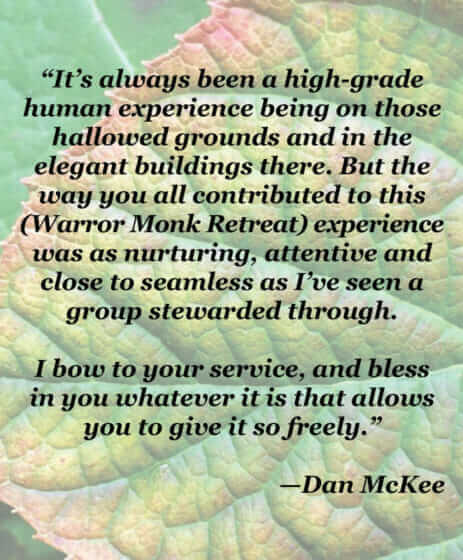
Dan McKee, of Awakening Life, has been bringing his Warrior Monk work to the Whidbey Institute for 10 years. We were privileged to interview him in 2014 in order to better understand his work and the Warrior Monk Threshold Retreat process. About his choice to hold the work at the Whidbey Institute, he said, “it’s imperative that “threshold” or “liminal” work take place in a natural and secluded environment. Chinook is among the best retreat places in the world for creating this kind of cauldron. In my experience, the place and its people, its history and future, and even the weather in the Northwest forest at this time of year all seem to conspire to create the deepest nest for us to safely drop into. The fact that the food is the tastiest healthy food in North America doesn’t hurt, either.”
As a program facilitator, Dan McKee has given several of our staff members the gift of Warrior Monk retreat participation. Additionally, in 2014 he graciously donated his time to facilitate several staff retreats. We worked together on skills to build even greater depth into our trusting, collaborative relationships in service to the Institute, its mission, and ourselves as whole people in our chosen professional environment. His expert facilitation allowed us to explore interpersonal dynamics and organizational culture during a year in which our team evolved significantly in roles and effectiveness. We thank him for his gift of time and knowledge, which helped make the year an incredibly successful one!
Whidbey Camano Land Trust
We are privileged by our continued partnership with the Whidbey Camano Land Trust, both on the Chinook land and in our Island community. In addition to holding conservation easements for much of our 100 acre Chinook Land, the Land Trust has been a partner in providing community education opportunities.
The annual Whidbey Camano Land Trust monitoring walk took place here at Chinook in late July. Jessica Larson and Ida Gianopulos, from the Land Trust, walked the conservation easement with Maggie Mahle and Thomas Anderson, clarifying boundary questions.
In the Spring, we worked with Whidbey Camano Land Trust and Good Cheer Food Bank development staff to offer a collaborative day-long seminar designed to help community members understand the ins-and-outs of planned giving . . . why, how, and when they might give, and what kind of difference each person can make right here at home, for their lifetimes and beyond. Not only was it a great opportunity for curious community members to receive information on a topic of interest to many, but it was a symbol of our Island-wide, inter-organizational philosophy that abundance springs from collaboration, not competition—and that true wealth comes from relationships of mutual support and trust.
The Whidbey Camano Land Trust offered a Walk & Talk with Fungi Tour at the Whidbey Institute in the fall, led by Conservation Assistant Ida Gianopulos. WhidbeyTV’s Walk and Talk with Fungi episode was filmed on the land at Chinook in 2013 and aired in 2014. View a brief clip from the episode here!
“The world is calling for our engaged action.” —Nina Simons
SALISH SEA BIONEERS’ BIOREGIONAL PERSPECTIVE
 Inspiring a shift to live on Earth in ways that honor the web of life, each other, and future generations, Bioneers seek nature-inspired approaches to the world’s most pressing environmental and social challenges. Bioneers is a national nonprofit organization providing a fertile hub of social and scientific innovation since its first conference in 1990, and is building a global network of organizations and communities learning from and supporting one another.
Inspiring a shift to live on Earth in ways that honor the web of life, each other, and future generations, Bioneers seek nature-inspired approaches to the world’s most pressing environmental and social challenges. Bioneers is a national nonprofit organization providing a fertile hub of social and scientific innovation since its first conference in 1990, and is building a global network of organizations and communities learning from and supporting one another.
The Whidbey Institute has been a home for the Bioneers conference in this region for five years. In 2014 we took a major step, expanding to include a Seattle-based networked learning community through our satellite office at Impact Hub Seattle and rebranding the program from Whidbey Island Bioneers to Salish Sea Bioneers in honor of our growing attention to bioregional issues, cultures, traditions, and solutions.
As a local, self-organized Bioneers group, Salish Sea Bioneers offers community, inspiration, and nature-inspired solutions for the region and the planet. Each Salish Sea Bioneers Conference is simultaneously an incubation chamber for the next generation of youth leaders, a community commons where we can reconnect, and a classroom where each of us can deepen our understanding of our planet, our work, and ourselves.
2014’s Salish Sea Bioneers Conference speakers included Bioneers Founder and CEO Kenny Ausubel; Native poet and activist Lyla June Johnston; Seattle hip hop artist, Prometheus Brown; and former Mayor of Seattle Mike McGinn, just to name a few. We also celebrated our fifth anniversary with some special additional offerings: a free kick-off party at Impact Hub Seattle, a special evening dinner at Chinook with Kenny the night before the conference, and a Sunday afternoon panel discussion on the life and work of Thomas Berry.
Click the photo thumbnails below to view a gallery of images from the November Conference.
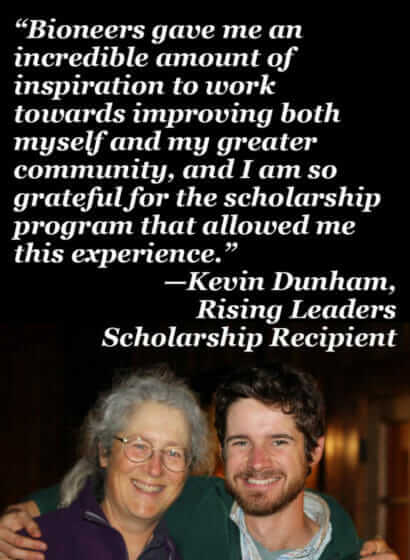 OUR RISING LEADERS SCHOLARSHIP FUND
OUR RISING LEADERS SCHOLARSHIP FUND
We believe in the power of thriving communities to cultivate innovative and lasting solutions to our communities’ greatest challenges. We know that we are far stronger together, working across all lines of difference. We see that each and every cause and movement for change is essentially interconnected and that we are all, ultimately, working toward systemic cultural change. At this critical moment in history, we need each of our voices to be heard as we dream, innovate, and act together to build a world that works for all.
We created the Rising Leaders Scholarship Fund in 2014 to help our community invest in young and low-income individuals who are stepping up to make a big impact in their communities. The Fund supports these rising leaders by providing need-based scholarships to help cover the costs of their participation in key Whidbey Institute programs. We support the fund with donations, fundraising events, and sales of Chinook Blend Coffee, which is custom-roasted for us from pesticide-free, farm-direct beans by our community partners at Mukilteo Coffee Roasters.
The Rising Leaders Scholarship Fund allowed us to provide 27 Salish Sea Bioneers Conference participants with significant support in 2014, and to help another dozen with minor support. Together, these recipients accounted for nearly one third of those present. Many were young change-makers visiting the Institute for the first time. About 50% of participants were under 40 years old, as were 13 out of 18 speakers and presenters (including those at our Seattle launch party)!
We deeply appreciate your shared vision and commitment to investing in the rising leaders of our time.
THE HEART OF THE CLIMATE MOVEMENT
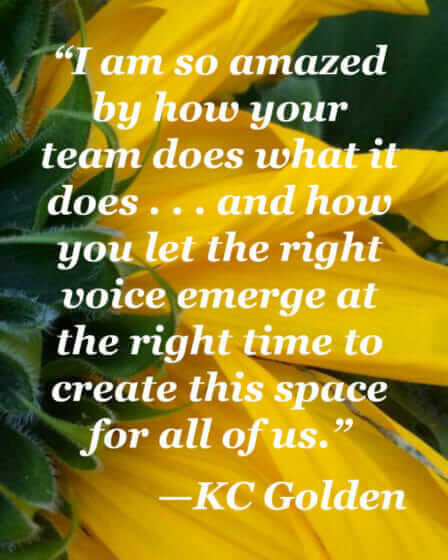 The work of our Cascadia Climate Collaborative continued to deepen in effectiveness and impact this year. Our second-annual conference for regional climate leaders took place in April and featured keynote presenters Kathleen Dean Moore and KC Golden. A strategically-selected group of 75 of the region’s most committed and effective climate leaders gathered at this invitational event to focus on the moral and ethical dimensions of the climate crisis. By providing a reflective space to share insights and experience, we’re working to build, strengthen, and amplify resilience in the Cascadian climate movement. With this and future efforts, it was our intention to help cultivate that intensely committed core of leaders who have the requisite moral depth, shared commitment, compassionate resolve, and strength of soul to sustain themselves and others through one of the most difficult transitions our species has ever faced.
The work of our Cascadia Climate Collaborative continued to deepen in effectiveness and impact this year. Our second-annual conference for regional climate leaders took place in April and featured keynote presenters Kathleen Dean Moore and KC Golden. A strategically-selected group of 75 of the region’s most committed and effective climate leaders gathered at this invitational event to focus on the moral and ethical dimensions of the climate crisis. By providing a reflective space to share insights and experience, we’re working to build, strengthen, and amplify resilience in the Cascadian climate movement. With this and future efforts, it was our intention to help cultivate that intensely committed core of leaders who have the requisite moral depth, shared commitment, compassionate resolve, and strength of soul to sustain themselves and others through one of the most difficult transitions our species has ever faced.
Watch our brief introductory video, produced prior to the 2014 conference:
Watch KC Golden’s full keynote presentation:
The conference closed with this public presentation by Kathleen Dean Moore on the moral and ethical dimensions of the climate movement:
“I believe that the community—in the fullest sense: a place and all its creatures—is the smallest unit of health and that to speak of the health of an isolated individual is a contradiction in terms.” ― Wendell Berry
COMMUNITY THROUGH THE LENS OF HEALTH
The Whidbey Institute’s Thriving Communities Initiative and members of diverse communities gathered in March 2014 at the Third Annual Whidbey Institute Thriving Communities Conference to explore community through the lens of health. The gathering aspired to build a larger awareness of the challenges we face today while offering replicable, proven answers to those challenges.
At the conference, we premiered several short video documentaries that demonstrate examples of individuals and organizations doing exceptional work to impact community health in a manner which supports thriving. These included:
- A local end-of-life care facility staffed by volunteers
- A medical school whose mission focuses on the underserved in a very vulnerable community
- A medical support fund supported by community investment
- A co-op serving families in need of housing and healthcare.
Jerry Millhon’s end of 2014 transition from the Executive Director role into Thriving Communities program leadership was triggered by his hunger for even more of this work in his life and in the world, and in an interview with Communications Manager Marnie Jones he said he is pulled to attend to the thing he loves most. “I sense the unbelievable hunger in the world for stories and replicable actions that are contributing to a positive impact. It feels really important to apply as much of my time as I can to the buildup of a sustainable flow for Thriving Communities.”
Watch our 2014 Thriving Communities documentaries:
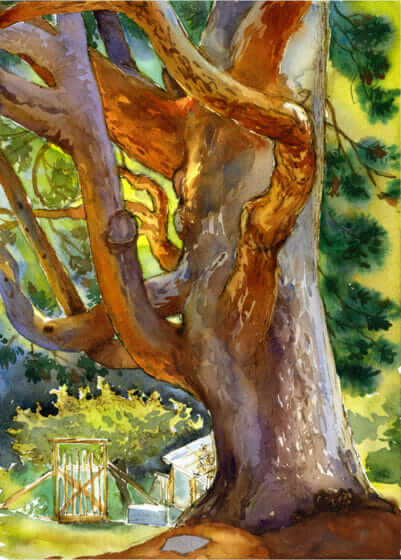 A FIFTH SEASON: STORIES IN WOOD
A FIFTH SEASON: STORIES IN WOOD
We wish to thank all who joined us to honor the legacy of our two beloved white pine trees at our gallery during the holidays. Our partnership with Live Edge Woodworks and the talented members of the Whidbey Island Woodworkers Guild yielded a bounty of beautiful keepsake furnishings and items which keep the legacy of our beloved trees alive in our hearts and homes. View these photos from the show. The watercolor painting at right, By Kris Wiltse, was sold as framed and unframed prints during the show which also included puzzles, figurines, and fine furniture.
The pine trees beside the historic Farmhouse at the heart of Chinook, originally planted by a Finnish immigrant family in the late 19th Century, stood watch over generations of visitors to this land before falling terminally ill and being removed due to safety concerns. We appreciate our community artisans and neighbors for the care their stewardship of the trees’ memory.
Along with the many local friends and community members who came out to support us with their purchases, buyers at the sold-out show included two great granddaughters of Frans Oscar Pietila, of our historic Pietila Farmhouse. Brenda Johnson, a great-granddaughter of Frans, expressed her relief that the Farmhouse will no longer be in jeopardy during windstorms and her gratitude for a chance to own such a significant keepsake. “”The property has been beautifully taken care of,”
she said,” and each of us in the family are forever grateful for the opportunities to return back to the farm . . . thank you so much for all of your help with helping us to have this piece of our family history!”
Our partnership with Live Edge Woodworks extended through the end of the year as they worked with us to create and sell dozens of beautiful live edge tables from the pine slabs. Some of our dearest friends now have these pieces in their homes as another testament to their love of the pines and of the Chinook land.
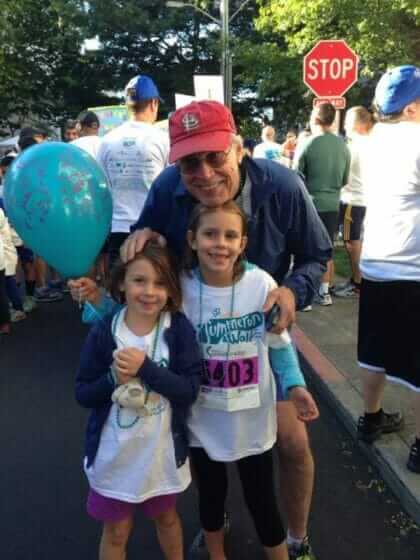 HEARTSONGS: A THRIVING TRANSITION
HEARTSONGS: A THRIVING TRANSITION
As Whidbey Institute Executive Director for five transformative years, Jerry Millhon professes to have followed a cardinal rule: “hire people better than yourself.” While those of us on the staff would argue that Jerry’s a match for us all, we do see his attention to team-building bearing fruit. Most of us are here because of Jerry’s leadership, the culture he helped create, and the potential that he saw in each of us to fill the right role at the right time for the health of the whole organization.
As 2014 came to a close, Jerry followed his heart’s calling and stepped fully into Thriving Communities Initiative (TCI) program leadership—a shift which brings to a close his five years of service as Director.
Thriving Communities launched with a 2012 gathering around local food systems. Since then, the body of work has grown to cover topics including local economy and health, and has both showcased and nurtured community-building programs in over 33 communities around the Pacific Northwest. In 2014, Jerry committed even more fully to helping it grow into something even greater. “I want to be in the gravel, in the dirt,” he said. “I’m not talking about heady ideas: I want to be able to see eye-to-eye with those people who, for some weird reason, started something that has actually changed the fiber of a community. I want to feel why and how, and give people confidence in what they could do in their own community. Those are stories and conversations that don’t have an end.”
We are honored and privileged to enjoy Jerry’s continued partnership as he leads one of our key programs, now in the role of a volunteer program leader. Our new executive team, Co-Directors Heather Johnson and Bill Koenig, share years of experience in Whidbey Institute leadership—Heather having been our Associate Director for four years, and Bill having been a former member and chair of the Whidbey Institute Board of Directors.
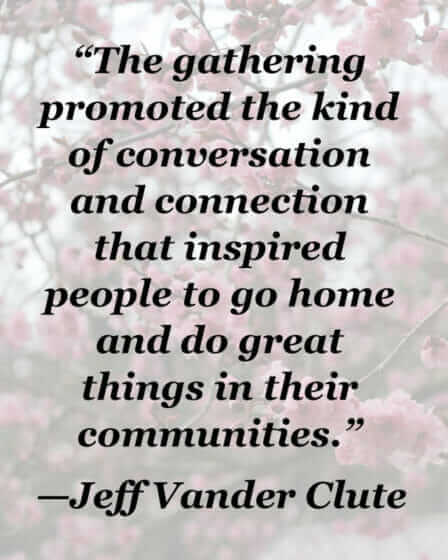 CIVIC INFRASTRUCTURE YOU CAN SEE
CIVIC INFRASTRUCTURE YOU CAN SEE
Author John Backman of the Orton Family Foundation’s Community Matters program authored a 2014 story on how we’re bringing people together through our Thriving Communities Initiative. Here’s an excerpt from the article:
Sometimes the raw materials of civic infrastructure are there but the connections are missing. Sometimes the connections are there but nobody sees them.
South Whidbey falls in the latter category. The residents of this Washington State community—about 20,000 people on the southern portion of Whidbey Island in Puget Sound—know one another well. Local organizations often work on similar issues. If any community would know its civic infrastructure, South Whidbey would.
And still the videos, highlighting unique and compelling community projects around the theme of food, surprised everyone.
“We all get so involved in our work that we sometimes don’t even acknowledge the wonderful overlaps,” said Jerry Millhon, executive director of the Whidbey Institute. “Video can showcase these connections and how powerful they could be.”
Read the rest of the article at www.communitymatters.org.
WHIDBEY ISLAND: REFLECTIONS ON PEOPLE AND THE LAND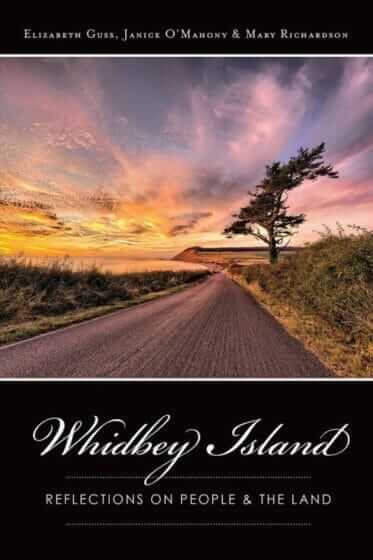
The Whidbey Institute’s story was one of 14 featured in Whidbey Island: Reflections on People & The Land, by Elizabeth Guss, Janice O’Mahony, and Mary Richardson, published in 2014 by History Press. In a chapter addressing our organizational history, our Chinook land, our built spaces, and our programs, including Bioneers and the Cascadia Climate Collaborative, the authors get to the heart of how this place holds the Whidbey Institute’s work. Larry Daloz, former Institute director and board member, is quoted in the book as saying, “as long as the Whidbey Institute stays involved with work that truly matters, work that is connected to the land, it will persist.”
The work touches on local history from pre-20th Century through today, and includes chapters on other organizations, parks, preserves, and public spaces. “From the early settlements of Native Americans and Europeans, to federal involvement with the Civilian Conservation Corps and the U.S. Navy, continuing through the activism in the 1960s and 1970s, this is the story of Whidbey Island.”
Co-author Mary Richardson joined us for our neighbor dinner in September to share stories from the book with Chinook’s closest neighbors. We thank the authors for their telling of the Whidbey Institute’s story!
“When one tugs at a single thing in nature, he finds it attached to the rest of the world.” —John Muir
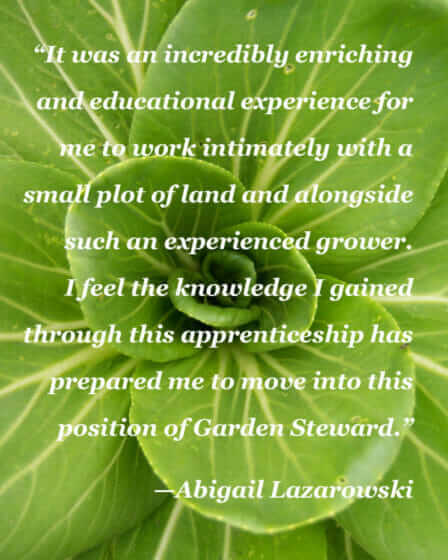 LEARNING THROUGH SERVICE
LEARNING THROUGH SERVICE
We were delighted to welcome Abigail Lazarowski to our team in late March as our Community Garden Leadership Training (CGLT) apprentice. She arrived from the East Coast, and found herself quickly growing roots in the Cascadian soils of Chinook. At the close of 2014, Abigail recommitted to Chinook by accepting a permanent position as Westgarden Steward and CGLT Co-Coordinator with Cary Peterson. As part of her evolving role, Abigail helped to plant, tend, and harvest our Westgarden vegetable beds. With the help of Abigail, Maggie Mahle, and committed volunteers, we grew a total of 1,956 pounds of produce in 2014. 254 pounds went to volunteers and staff, 984 pounds went to our Institute kitchen, and 718 pounds went to feed our community through the Good Cheer Food Bank.
We thank Chris Shipway, who volunteered at the Whidbey Institute for 70 hours in the Spring of 2014. He worked on a forest restoration project, assisted with various land maintenance, and helped the Whidbey Camano Land Trust with invasive plant removal on the Chinook land.
In February, instructors Tom Murphy and Erin Ryan returned to Chinook with a hardworking crew of students from Edmonds Community College’s Learn and Serve Environmental Anthropology Field (LEAF) School to work with Maggie Mahle to learn about the fertility cycle and soil building. The planned activity—flipping beds—was deferred due to frozen ground, so they discussed pine blister rust at the site of the felled white pines and then engaged in a service project by clearing small and large wood debris from the open forest area near the heart of Chinook. This material is being composted for use in the Hügelkultur tradition, which employs rotted wood to create nurselog-like conditions in the garden bed. They also moved gravel into the greenhouse floor via bucket brigade, then closed with reflections in the Sanctuary.We offer our thanks to the students and instructors for their effort, assistance, and learning! We are grateful for our ongoing partnership with LEAF.
A big thank you to John Baumgardner, Justin Brooks, Kahte Culevski, Muriel DeKlerk, Daryl Douglas, Stephanie Frank, Erin Haley, Kymberly Hoyle, Sylvia Lin, Hubert Ly, Alec Meade, Chelsea Rabourn, Mac Repman, Sierra Rudnick, Hannah Siebart, Al Tidmore III, Erin Gamble, Christopher Shipway, Laurie Ross, Erin Ryan and Professor Tom Murphy!
LET IT FLOW! IRRIGATING OUR WESTGARDEN
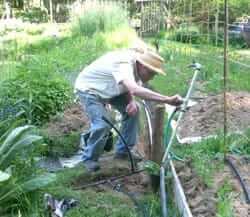 Those among you who visited the Westgarden in 2014 will know it as a vibrant, thriving, bountiful space. A significant ingredient in our flourishing garden is water, and after a lengthy process researching and rehabbing a historic irrigation system and adding new piping and fixtures, watering the garden has become much, much easier!
Those among you who visited the Westgarden in 2014 will know it as a vibrant, thriving, bountiful space. A significant ingredient in our flourishing garden is water, and after a lengthy process researching and rehabbing a historic irrigation system and adding new piping and fixtures, watering the garden has become much, much easier!
Our 2014 Westgarden irrigation project was funded in part by a grant from the Whidbey Island Garden Tour, and it began with exploration. “There was an old system in here that had been cut off,” Maggie Mahle explained. The water line which had once run from the Farmhouse had been interrupted, so techniques ranging from digging and probing to sluicing and dousing were employed. “We thought we were going to have to retrench everything, but we found the buried pipe that came from the Farmhouse. There were many steps involved, but we figured out how to attach it and where it went, then dug many holes in the garden looking for the pipe.” After the main water line was repaired, the team continued to search for breaks in the old system throughout the garden. The project, in which Beno Kennedy and Cary Peterson were driving forces, spanned several months in early 2014. Our May Work Party provided an opportunity for a team trenching effort, and staff collaborated to close in the trenches in June. Now, the garden is graced with new hydrants and an extensive network of underground pipes with connections to above-ground drip irrigation.
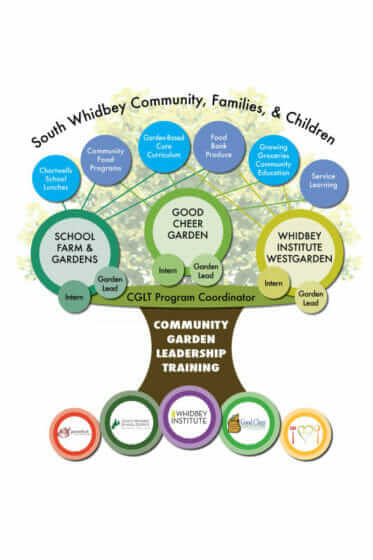 DEEPENING GARDEN PARTNERSHIPS
DEEPENING GARDEN PARTNERSHIPS
We’re growing stronger food networks on South Whidbey.
Representatives from the Whidbey Institute, Whidbey Island Nourishes, Good Cheer, and Goosefoot met last Spring with the South Whidbey School District (SWSD) Superintendent and all four of our Community Garden Leadership Apprentices to discuss how to collaborate, with the strength of our shared missions, to bolster the school garden programs on South Whidbey. Summit discussion included how to fund a school garden program for the entire district and how to bring garden curriculum to the classrooms plus fresh, garden-grown produce to the cafeterias.
SWSD cafeteria food service is provided by Chartwells, a national food service company providing 2.5 million school lunches across the nation each day. Our district is the first in the nation to provide school-garden grown produce to a Chartwells cafeteria on a regular basis, setting a precedent with the potential to impact millions of lives!
Stakeholders came away with the goal of raising funds and fostering programs to meet the challenge of getting garden-based curriculum integrated into core learning at every grade level, K through 12, within three years, and to continue improving access to garden learning and organic produce for every student. Community garden coordinator Cary Peterson said, “five organizations getting together to raise money for a program that furthers a common vision is a very cool thing. Through collaboration and cooperation, we’re all helping each other achieve our goals.” After the meeting, Goosefoot stepped up and helped SWSD raise $44,000 for the School Garden with a $22,000 matching grant.
You helped the Whidbey Institute raise $20,015 in donations for our Community Garden Leadership Training program in November and December—half contributed by you, our dedicated community, and the other half given as a $10,000 matching grant by Hand in Hand Partnership!
We’ve worked in collaboration with Good Cheer Food Bank and the South Whidbey School District to run this program since 2011. With your support, we can now offer stipends to qualified apprentices and pay wages to Cary Peterson (community garden mentor) and Abigail Lazarowski (Westgarden steward) for their deepening engagement as professional co-coordinators of the program. The entire South Whidbey community benefits.
Our partner gardens work together to nourish our neighbors through the Good Cheer Food Bank, contribute fresh food to the backpack lunch and vending machine programs of Whidbey Island Nourishes, and nurture students’ bodies and minds with fresh produce in school lunches and engaging curriculum in the gardens. We are grateful to each and every donor, volunteer, partner, and garden apprentice who’s helped us in this work.
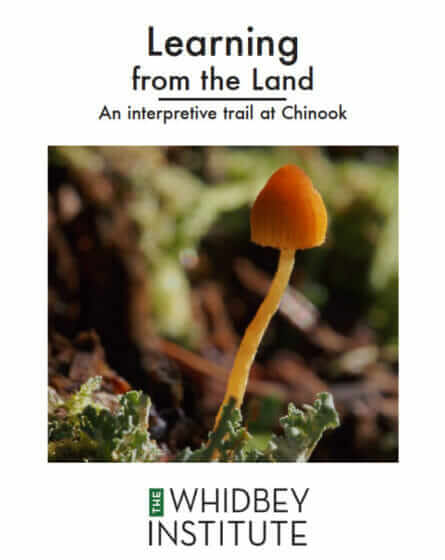 WATERSHED STEWARDSHIP AT CHINOOK
WATERSHED STEWARDSHIP AT CHINOOK
Clean water and healthy forests are deeply interdependent. At Chinook, we carefully steward both. We were honored to be the Whidbey ECO Network’s April Featured Spotlight Organization in 2014, and glad of the opportunity to share our perspective on how all of us can protect our Whidbey waters.
Two watersheds meet at Chinook, with a raindrop falling on the north side of Old Pietila Road traveling to Miller Lake, and another falling on the south side traveling to Quade Creek. We have a third wetland area just north of the Westgarden, where we practice organic gardening methods to provide food for our programs, chef, staff, and community Good Cheer Food Bank. Our natural gardening methods, which include vermiculture, mulching, and raised beds, have minimal impact on the watershed and help prevent topsoil loss.
We take our stewardship of this 100 acre forest seriously, and appreciate the positive impact of forest health on local waters. Partnerships with the Whidbey Camano Land Trust and surrounding neighbors allow us to better protect the wild spaces in our care. Our Wetland Loop Interpretive Trail (pictured at right) provides visitors with a self-guided tour of a wetland habitat, introducing them to principles of wetland health and some of the native species that call this place home.
The Whidbey Institute’s Forest Stewardship Plan, prepared in 2006, provides guidelines for forest and watershed protection. Most of our 100 acre forest is in a conservation easement with WCLT, to preserve water purity, protect habitat for wildlife and native plants, and provide educational opportunities.
This document states that it is our intention:
- To serve as a sustainable habitat for diverse species of native wildlife.
- To protect the upper watersheds of two tributaries of salmon-bearing Maxwelton Creek.
- To provide a rich educational setting for program participants and the general public to learn the principles of forest ecology and responsible human relationship to the earth.
- To offer a place of serenity and renewal in a natural setting for all guests of the Institute as well as for the surrounding community.
In 2014, the Whidbey ECO Network’s message was “Whidbey Waters are in Your Hands.” Our hope for our neighbors and community members is that you can join us in preserving habitat; using low-impact, low-erosion gardening techniques; leaving native wetland vegetation in place; and conserving forest tracts.
“Can we create soulful workplaces—schools, hospitals, businesses, and nonprofits—where our talents can blossom and our callings can be honored?” ― Frederic Laloux
WARM WELCOMES
Our team evolved in 2014 as new staff and board members joined in the stewardship of our land, our work, our programs, and our spaces. We welcome these new colleagues:
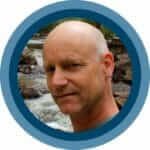 Thomas Anderson
Thomas Anderson
Thomas came on board in February. With his deep love of the land and people at Chinook and his ten year history participating in and facilitating work at the Institute, he was a natural fit for the role of Resident Caretaker.
Thomas lives onsite and works with the event team to ensure all participants and visitors find a welcoming and nourishing home at the Institute. He supports the land and facilities crews, helping to create an environment that facilitates the life-affirming work happening here. As a photographer, filmmaker, contemplative juggler, and teacher of movement awareness, Thomas seeks to inspire a sense of wonder and delight in our relations with Earth and Other.
Melissa Dowd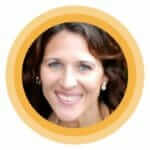
Melissa joined our team in the summer in a database administration role, and has been embraced by the team both for her professional talents and for her commitments to honesty, communication, and personal growth. She’s a mother, wife, and professional life coach, with a deep commitment to teaching her children to live naturally in alignment with the very values for which the Whidbey Institute stands.
Melissa is excited about the new connections she’s been forming at the Whidbey Institute, both with people and the land. “A patch of dirt can make me weep,” she said. The care she feels for the land is mirrored in the care she takes of herself and others. “I drew the Whidbey Institute and the Whidbey Institute drew me,” she said. “It matters to me to be in a community committed to things like peace, connectivity, and collaboration.”
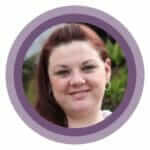 Amber Herman
Amber Herman
Amber joined us late in the year as a member of our housekeeping staff. She’s a dedicated mother of two sons (Victor, age 15, and Dillon, 9) and two daughters (Megan, 12, and Kirsten, 7) .
Being a mom keeps her very busy, between football games, baseball games, wrestling matches, and Girl Scout meetings. She also enjoys making jewelry and knitting, and finds time in her busy family schedule for her crafts.
Amber has lived on Whidbey since she was 16, and now makes her home near Saratoga with the kids and her partner of 17 years, Kirk. At work, we’re enjoying getting to know Amber as a friendly, hard-working, and generous co-worker.
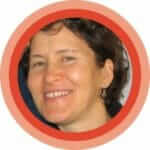 Kimi Hoover
Kimi Hoover
Kimi has had diverse professional experiences, from teaching Environmental Science to studying French cuisine to working as a Department of Ecology biologist. She joined the Institute staff early in the year as Facilities and Group Logistics Coordinator.
Kimi’s work at the Institute is supported by her deep care for people and the planet. Though trained as a biologist, with a Master’s degree in that field, she’s fascinated by teaching and studying Environmental Science, with a focus on sustainability issues. She is also a vegan nutritionist and an enthusiastic explorer of the outdoors, finding solace and rejuvenation in nature. She spent her early adulthood traveling extensively around the globe, from Belize to Alaska to Hawaii to Europe. Now, her explorations take her around the trails and waterways of Northwest Washington.
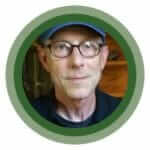 Beno Kennedy
Beno Kennedy
Beno Kennedy lives according to a simple philosophy: “I feel like if you take care of what’s in front of you, close by, then by extension you’re helping to take care of the world.” He joined the Whidbey Institute in the spring as a member of our Facilities Team, serving as a handyman/go-to-guy with extensive skills, a creative outlook, and a contagious attitude of honesty, service, and dedication.
Beno’s connection to this place extends back long before he joined our staff. “I came to Whidbey in 1981,” he said, “and I’ve been an occasional volunteer at the Institute. When Kim Hoelting built the Sanctuary, I was on that team.” Beno said that as a part of the team he had a hand in plastering, flooring, painting, roofing, and finishing the building! He describes his role as an opportunity to care for the physical plane and, by extension, the planet.
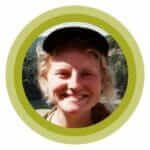 Abigail Lazarowski
Abigail Lazarowski
Abigail joined us in spring as our garden apprentice, then recommitted to her role at Chinook by accepting a permanent position as Westgarden Steward at the end of the season.
Abigail hails from Vermont, and her skills in building community, growing organic food, and helping those in need through her expanding knowledge of small scale vegetable growing have served South Whidbey well.
In 2014, some of Abigail’s focus was on hosting work parties and service learning projects, and helping provide food for our kitchen and community food bank.
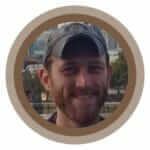 Robert Mellinger
Robert Mellinger
Robert came on board in fall 2014 to steward Chinook and support land-based programming. His academic and professional background includes experience in holistic science, wilderness ecology and education, transformative learning for sustainable living, permaculture design and landscaping, and ecological literacy. He is excited by the Chinook land and opportunities in collaborative organizational stewardship, community engagement, and land-based education.
There’s been a strong thread running through Robert’s diverse career: a hunger for truly sustainable community. “I’ve worked at the interface of communities trying to understand what it means for them to live together ecologically, both in a physical way, in how they use their land and live on their land, and also in how they live together,” he said.
FOND FAREWELLS
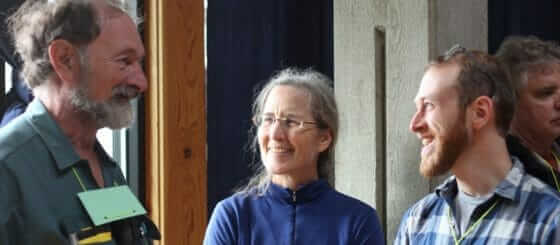 2014 was also a year of goodbyes, as our colleagues Maggie Mahle, Jerry Millhon, Allison Tongate, and Brittany Winchester left Institute employment for other opportunities.
2014 was also a year of goodbyes, as our colleagues Maggie Mahle, Jerry Millhon, Allison Tongate, and Brittany Winchester left Institute employment for other opportunities.
Maggie, former Land Care Coordinator, returned to her home in Colorado due to family needs, though not without expressing her deep and lasting gratitude to the Chinook land and friends she made here.
Jerry, former Executive Director, stayed on in our Institute family as Thriving Communities Initiative Program Leader (a volunteer position) where he can do his heart’s work.
Allison remains on South Whidbey, and has our deep gratitude for her years of service as Operations Manager.
Finally, we thank Brittany Winchester for her service as short-term housekeeping assistance staff in 2014 and congratulate her on her new role with Mukilteo Coffee Roasters!
“I slept and dreamt that life was joy. I awoke and saw that life was service. I acted and behold, service was joy.”— Rabindranath Tagore
A DEDICATED BOARD
Board president Gabriel Shirley, vice-president Kate Snider, and board members Dorothy Baumgartner, Dale Nienow, Sheryl Harmer, Cole Hoover, Christie Lynk, Victoria Santos, Barbara Schaetti, and Hilary Wilson continued in service to the Whidbey Institute through 2014. We thank each of them for their deep engagement and dedicated service.
Gary Jusela, Francis Janes, and Rick Paine completed their board terms in 2014. We thank them for their past service and continued friendship!
Francis initiated our major donor moves management effort and was the first advocate for board education and capacity-building related to development stewardship skills. Francis has been instrumental in forging key relationships for the Whidbey Institute, including with iLeap, on whose board he has served. Thanks to Francis’s relationship-building, the Whidbey Institute board now holds our Seattle meetings at iLeap’s facility.
Gary served on our board as a strong advocate for Thriving Communities and our strategic planning activities. Gary’s organizational knowledge and experience helped us think through some of the key elements of our strategy for the future.
Rick was a two-term (six year) board member who held steady on the Finance committee during very lean times. Rick brought a huge heart to his work at the Institute, delivering hard messages when necessary and always showing up with deep compassion for our work.
OUR COMMITTED COLLEAGUES
We thank these committee members for their focused engagement in specific and vital areas of the Institute’s 2014 work:
EXECUTIVE COMMITTEE: Gabriel Shirley, Kate Snider, Francis Janes, Jerry Millhon
Key Focus: The executive committee works on behalf of the Board, and represents the Board in actions deemed necessary during an emergency. Its secondary purposes include providing agendas in advance of each Board Meeting; mid-month check-ins on financials and other business; feedback in direction and trend discussions; and brain power on topics needing input.
GOVERNANCE COMMITTEE: Barbara Schaetti, Dorothy Baumgartner
Key Focus: This Committee’s work focuses on the systems that support our human resources, like our charters, policies, and by-laws. A major project of 2014 was working with staff to organize the design of a new governance model in support of our strategic plan. Chris Clark, Thomas Anderson, Bill Koenig, Heather Johnson, Kate Snider, and Rick Jackson provided particularly invaluable support.
FINANCE COMMITTEE: Wendy Fjelsted, Tom Buxton, Don Luby, Barbara Schaetti, Rick Paine, Jerry Millhon, Heather Johnson
Key Focus: This critical group oversees the nuts and bolts of our budgets, balance sheets, and profit and loss reports. Each member brings a unique perspective from diverse professional backgrounds. Their work informs the direction of the Board, Staff and other committees.
DEVELOPMENT COMMITTEE: Kate Snider, Sheryl Harmer, Hilary Wilson, Cole Hoover, Gabriel Shirley, Francis Janes, Jerry Millhon, Allison Tongate
Key Focus: Approximately 50% of our activities rely on contributed income, and the development committee is responsible for stewarding the fundraising efforts of the organization to meet those needs. The 2014 activities were nothing short of astonishing, and included launching an annual campaign through Seattle Foundations’ GiveBig and our first annual Gratitude Gala. The stretch goal of raising nearly $100K more than break-even budget was necessary to move the organization out of a debt cycle. This goal was achieved!
DEVELOPMENT TASK FORCE: Doug Kelly, Earl Lasher, Rick Paine, Mary Willis, Jean Singer, Tracy Robinson, Allison Tongate, Jerry Millhon
Key Focus: This group is a think tank of wisdom keepers who deepen the context of our philanthropy work and enhance our ability to identify high leverage opportunities, assess needs and goals, and develop actionable, practical strategies.
THANKING OUR GIVEBIG DONORS
Our first year participating in Seattle Foundation’s GiveBig, a 24-hour day of giving, was a tremendous success thanks to the 200+ individuals who donated! We give our special thanks to Linda Sue Park, whose incredibly generous challenge grant through the Linda Sue Park Fund for Gaia helped match your gifts one-to-one. Your giving power grew even more through the Seattle Foundation’s stretch pool, and we raised consciousness about who we are with a whole new audience!
The money we raised on May 6 helped us care for the land, funded much-needed energy efficiency and sustainability improvements to facilities, helped provide staff with a living wage, and increased our ability to provide scholarships for people of all ages and backgrounds to attend Institute programs.
IN LOVING MEMORY
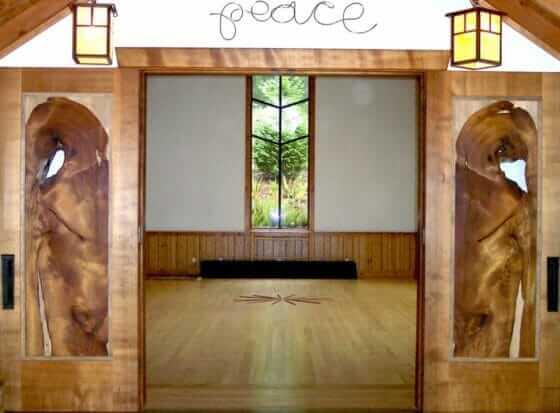 Margaret Lloyd
Margaret Lloyd
Margaret lived with courage and commitment, working on behalf of a new understanding of our relationship to the earth and to each other. She spent her life generously engaging with and supporting significant, prophetic endeavors.
She died on January 13th, 2014 at the age of 97. She leaves a legacy which includes Thomas Berry Hall, as well as other structures and programs around the country.
Margaret first visited Chinook in the 1970s, and remained a friend of the community thereafter though she lived in New York City. In 1997, sharing the aspirations of Fritz and Vivienne Hull, she made an extraordinary gift that provided the funding for the building of Thomas Berry Hall as well as program support in the early years of the Whidbey Institute. She deeply understood the work of Thomas Berry, and her gift created a distinctive place for the emerging work for Earth, Spirit, and the Human Future that he inspired.
In the 15 years since completion, this beautiful Ross Chapin-designed structure has been counted among the most distinctive of gathering places on Whidbey Island and in the Northwest. It has held meetings and gatherings of major importance, along with graduations, memorials, concerts, and a few great parties. Margaret’s gift profoundly changed the culture and opportunities of the Institute. We continue to grow into the power of the space.
To her family, and to all who knew Margaret, we express our gratitude for the manifold ways in which she delighted, challenged, and supported us across three decades of meaningful friendship and inspiration.
Judith Yeakel
Judith was born at sunrise, Mar. 14, 1929, and passed away at sunset, Jan. 28, 2014. Her impact on Whidbey Island was profound. Her presence in all discussions was appreciated. Her ability to listen to those around her was unique. Her care for so many is her legacy.
There are many organizations that have felt Judith Yeakel’s impact. Stories of her care and support go far beyond Whidbey Island. For the Whidbey Institute, the story is very clear, and Judy’s legacy will long be felt. The Sanctuary at Chinook is one of the most cherished and unique structures in this bioregion. Judy just wanted to be sure that there was a chapel-type structure on the land: a place for quiet, for contemplation and for prayer. The Sanctuary was a gift to the Institute which Judy envisioned as necessary to provide balance to the other structures (Farmhouse and Thomas Berry Hall) that had their own place on the Chinook land.
Today, the beauty of her thoughtful insight—her vision of need, structure and balance—is evident. The Sanctuary holds space for deep contemplation, for reflection, and for small gatherings that invite connection between people. As important is the seamless and visible connection with natural world, the spirit within, and the people who grace the building. It is her permanent way of sharing with all of us. The structure is indeed a metaphor for Judy’s life and a permanent gift, a legacy, for all who enter.
To Judy’s wonderful family we send our love and appreciation for her life well-lived. To Judy Yaekel, we cherish her memory and offer our thanks for leading us down the right path.
Martin Selch
On September 1, 2014, our community lost a beloved friend.
Martin Wiebe Selch died at Whatcom Hospice House three weeks after suffering a head injury while bicycling. In addition to counting him among our friends and colleagues, we at the Whidbey Institute considered Martin a mentor in the art of living sustainably. Martin worked closely with Institute staff and site committee members in 2012, in his role as Sustainable Connections’ Commercial Conservation Specialist. The energy audit and recommendations he provided helped launch our Green Initiative, and we’ll never forget the camaraderie and counsel we enjoyed while working alongside him. His legacy at Chinook can be seen in current projects such as last week’s replacement of our commercial refrigeration units with new EnergyStar appliances, and next week’s scheduled replacement of the Thomas Berry Hall oil boiler with a planet-friendly heat pump.
Martin’s obituary describes him thus: “He was the best dad, husband and son that anyone could hope for. He had an amazing, analytical mind and an insatiable curiosity to learn more about almost anything. He enjoyed working with his hands and had a gift for building and repairing things. He had a positive attitude and a great sense of humor. Martin loved being physically active which evolved into a passion for being above tree-line and living a little gentler on the earth. His footprint in his field of work was larger than he would acknowledge.” Here, at Chinook, his passion for treading lightly has left a deep impression.
We offer our condolences to the wife and sons he leaves behind.
“Everybody needs beauty as well as bread, places to play in and pray in, where nature may heal and give strength to body and soul.”—John Muir
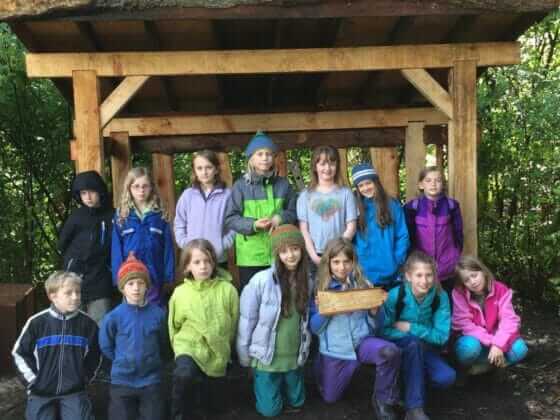 WALDORF STUDENT BUILDERS
WALDORF STUDENT BUILDERS
Our first White Pine Project was completed by a team of young neighbors, using the lumber milled from our two felled giants!
Waldorf third graders worked tirelessly and with tremendous focus, determination, and camaraderie to build a beautiful woodshed with the leadership of Waldorf parent Eric Gelfand and our Resident Caretaker, Thomas Anderson, with additional guidance from Brian Boyd, Mr. Carlson, Nick Toombs, and Robyn Calvin. This effort was both a learning opportunity and a gift, from the students, to our greater community. As noted in a WIWS newsletter story on the subject, “nothing could have been achieved without the donation of wood and roofing materials provided by Kim Hoelting and his mill chief, Geoff Paul.”
The woodshed is a beautiful testament not only to the children’s hard work and craftsmanship, but also to their love of this land: it sits beside a fire pit which has stood as the center of many reverent circles, seeming quite at home beside the forest. We thank the students and their mentors for their stewardship of this space at Chinook.
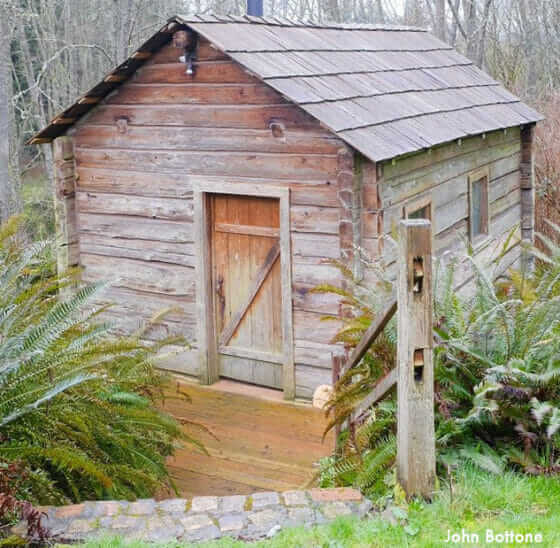 A PIECE OF HISTORY
A PIECE OF HISTORY
Our 1920’s era Finnish sauna is one of the earliest structures still standing at Chinook, primarily because of a remodel in the 1970s and ongoing care through the 80s by Chinook members. No significant maintenance had occurred yet, so we were delighted when our facilities team undertook a Sauna repair project!
In 2014, we pressure-washed and repaired the stairs and deck; repaired the brick hearth with insulation and leveling of the stove plus a new steel lintel; repaired a long-standing roof and skylight leak; replaced the rotten stove pipe and cap; repaired and remodeled the outdoor shower area; repaired the floor and doors; and deep-cleaned the interior.
The sauna is now ready for regular use, and we are looking forward to 2015 projects which will include reconfiguring and installation of new, safer stairs and railings; reinforcement of the hearth with mesh and stucco cement; and ongoing evaluation of the structure for continued longevity.
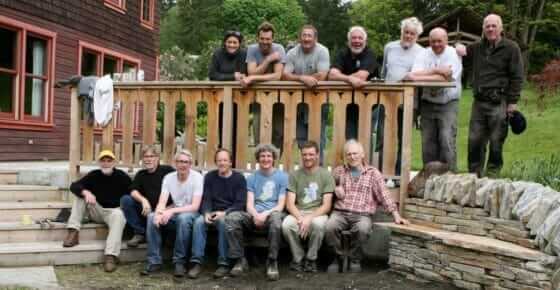 STORIES IN STONE
STORIES IN STONE
Stonefest Summit, hosted by Marenakos Rock Center, Scott Hackney, and Alexandra Morosco, brought together several dozen international players in the field of stonework at Chinook in May 2014. The gathering was a continuation of the work of StoneFest in expanding knowledge of stonecraft and creating space for personal growth through building a shared community in the trade. Participants worked shoulder-to-shoulder to build a stone feature on the Chinook land during the retreat, extending the new stone patio behind the Farmhouse to allow it to better integrate with the surrounding landscape.
Photo courtesy Stonefest. Standing, L-R: Alexandra Morosco, Marenakos/StoneFest; Nicholas Tomkins, Stone Foundation; Neil Rippingale, Dry Stone Conservancy; Bobby Watt; John Shaw-Rimmington, Dry Stone Walling Across Canada; Eric Landman, Dry Stone Walling Association of Canada; Pat McAfee, Feile na gCloch. Seated: Tomas Lipps, Stone Foundation, Scott Hackney, Marenakos/Stonefest; Rory Noone, Dry Stone Walling Association of Ireland; Carl Nelson, North West Stone Sculptors Association: Sunny Weiler and Ken Curran, Dry Stone Walling Association of Ireland; Nick Aitken, Dry Stone Walling Association (UK).
Our facilities team also beautifully refinished the concrete floors in Thomas Berry Hall in late 2014, extending their beauty, longevity, and aesthetic warmth.
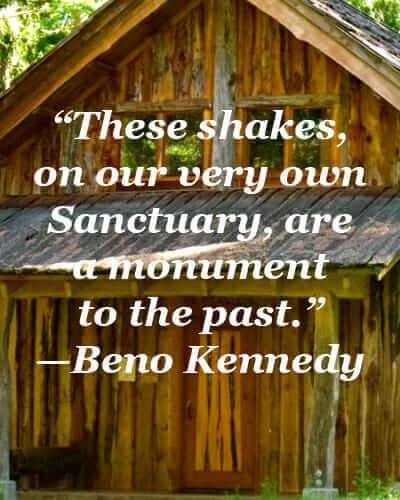 SANCTUARY ROOF RECOVERY
SANCTUARY ROOF RECOVERY
Our fifteen year-old Sanctuary has one of the most unique roofs in the Northwest. The three-foot cedar shakes on the main roof, plus ten-foot shakes on the porch, were hand-split by committed neighbors and friends through a process which is rarely undertaken now unless for a museum exhibit or Northwest tribal structure restoration project. In 2014, we did a full evaluation of the existing roof; deep cleaned the East side of the roof by hand, to avoid structural damage; and budgeted for completion of the Sanctuary roof recover project in the year to come.
The work ahead will include deep cleaning of the West side Sanctuary roof, repair and replacement of the sky light trim on both sides of the roof, and fascia restoration.
We thank Beno Kennedy for his leadership on this project and our committed donors, whose love of this structure has helped make this work possible.
“There is a new way of living taking birth in our time. I encounter it everywhere I go in this land, in cities and small towns, in churches and schools, where folks are fed up with violence and disease and alienation, where they are creating new forms, new lifestyles, determined to live in ways that lend meaning and sanity to their lives.”—Joanna Macy
 GREENING CHINOOK
GREENING CHINOOK
Thanks to all who donated through GiveBIG last May, as well as donors Tom Buxton and Andy Anderson, we were able to make major strides in our green initiative.
October marked the installation of our new Altherma air-to-water heat pump system. This groundbreaking technology has been widely used in Europe and provides a quiet, efficient, and steady heat source. It’s now the exclusive source of heat for Thomas Berry Hall, and also warms the dining room and kitchen.
The installation was coordinated by and partially funded by a grant from our green partner in Bellingham, Sustainable Connections.
The old oil boiler, which used about 1700 gallons per year, has been decommissioned, and according to our best estimates this new system will prevent 16 tons of carbon from entering our atmosphere each year.
2014 FINANCIALS
2014 marked an important achievement for the Institute: we fully paid off the debt which had accumulated through the years of the financial recession. We are celebrating this moment!
Moving into a healthier operating cash position is a 2015 priority. We have confidence this can be accomplished—through the support of our strong board and staff team, a brimming-full 2015 calendar with mission-aligned programs and contracts, and an incredible, engaged community. Thank you, everyone!
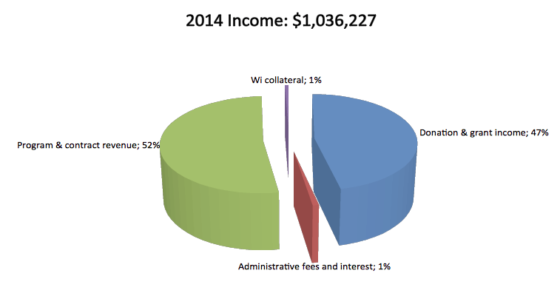
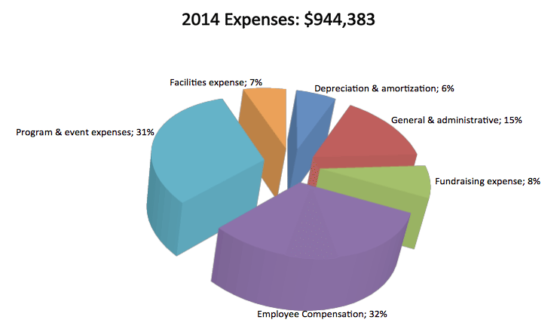
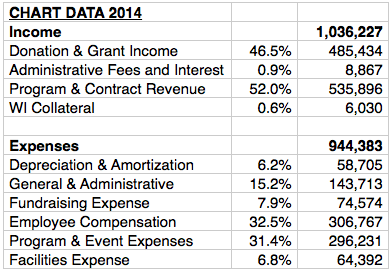
. . . . . . . . . . . . . . . . . . . . . . . . . . . . . . . . . . . . . . . . . . . . . . . . . . .
THANK YOU
FOR ALL YOU DO TO MAKE THIS WORK POSSIBLE!
WITH DEEP GRATITUDE—THE BOARD & STAFF OF THE WHIDBEY INSTITUTE
. . . . . . . . . . . . . . . . . . . . . . . . . . . . . . . . . . . . . . . . . . . . . . . . . . .
